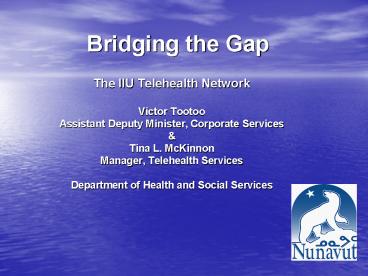Bridging the Gap PowerPoint PPT Presentation
Title: Bridging the Gap
1
Bridging the Gap
- The IIU Telehealth Network
- Victor Tootoo
- Assistant Deputy Minister, Corporate Services
- Tina L. McKinnon
- Manager, Telehealth Services
- Department of Health and Social Services
2
(No Transcript)
3
Nunavut - at a glance
- 24 of Canadas land mass
- 30,000 residents
- 85 Inuit
- 26 communities ranging in population 150-5000
- 50 of those communities have population lt 660
- Only accessible by air or sea (very short season)
- Capital Iqaluit
- Iqaluits population c. 5000
- Language Inuktitut, English, French
4
Bathurst Mandate
- Healthy Communities
- Simplicity and Unity
- Self-Reliance
- Continuing Learning
5
HSS Mission
- Promote, protect and provide for the health and
well-being of the people of Nunavut in support of
leading self-reliant and productive lives
6
What is our health status?
- Compared to national average
- 2x Infant mortality rate
- 3xTeenage pregnancy
- 6x Suicide rate
- 8x TB
- 13-20x STI
- 26x Solvent abuse
- 5x Violent crime
- 7x Sexual assault
- 50 of the population is less than 25 years of
age - 60 of adult population are smokers
- 42 of residents gt15 years have less than grade 9
education - 26-40 Unemployment rates
7
Care Closer to Home
- Allows people at great distances to unite and
communicate - Promotes family contact
- Timely access to health and social services
- Provides enhanced sense of partnership and
reduction in feeling of isolationism by health
and social services professionals
8
Telehealth A history lesson
- 1998 NWT installs 3 telehealth systems
- Project fails
- 1999 NWT installs 3 telehealth systems
- Marginal success
- 2000 NU installs 2 telehealth systems
- Marginal success
- 2001 NU takes a needs based approach and
upgrades 5 and add 10 new communities - 2004 NU adds 7 communities
9
Telehealth Program Goals
- Improve access to health care services including
health, social services, public health and
administration - Support the ongoing investment in Telehealth, by
expanding the infrastructure, service of
telehealth - Support staff providing health services in remote
locations through continuing education, enhanced
problem solving and greater participation in
patent care plans and delivery - Delivering tools to support the integration of
telehealth on the health and social services
delivery system, including health information and
access to other specialists/professional opinions.
10
What are the benefits?
- Diagnose/treat/rehab more people in their
communities - Timely diagnosis and treatment
- Increased support in emergency/triage situations
- Increase access to broader range of
practitioners/programs - Access to secondary and tertiary specialists
- Reduce travel costs and provide more cost
effective services - Reduced isolationism of practitioners
- Ongoing training/education and enhance program
administration
11
TelehealthWhat are the challenges?
- Existing infrastructure does not meet our needs
- Telco costs are expensive
- National standards have yet to be established
- Lack of human resources in the North
12
Categories of Telehealth Services
Clinical Educational Family Visitation Administration
Community Physician Clinics Dermatology Mental Health Psychiatry Paediatric Neurology Physiotherapy Occupational Therapy Audiology Speech Therapy Case conferences Discharge Planning Regional educational programs Territorial Education programs Southern Educational programs Pre Natal visits Maternal Visits Family Visits Administrative meetings - Regional - Territorial Steering Committee meeting Regional working group meetings Training for Site Technicians
13
Clinical
- June 2003 to August 2003
- Estimated 31 trips avoided _at_ 56,200.00
- October 2003 to February 2004
- Estimated 170 trips avoided _at_ 323,000.00
- Total patients serviced in community
- 201 patients/clients
- Total travel costs avoided
- 379,200.00
14
(No Transcript)
15
Education
Continuing Education Session Titles Continuing Education Session Titles Continuing Education Session Titles Continuing Education Session Titles Continuing Education Session Titles
Diabetes Suicide Prevention Pre natal Care Nutrition Guidelines for COPD patients
Paediatric Obesity Palliative care Respiratory and GI conditions OB Gynaecology FASD
Adolescent Addictions Bullying Use of antibiotics ER Rounds Environmental Health
Womens Health Mental Health Laboratory Procedures ENT Orthopaedics
Community Health Representative Training Child Protection Communicable diseases Health Records and coding Tuberculosis
16
Education
- April 2003 to August 2003
- 33 hours of educational activity
- Estimated travel costs avoided _at_ 132,000.00
- October 2003 to February 2004
- 327 hours of educational activity
- Estimated travel costs avoided _at_ 654,000.00
- Total hours 360 hours of education attended by on
average 3 participants 1080 attendees - Total estimated travel costs avoided 786,000.00
17
(No Transcript)
18
Family Visits
- April 2003 to August 2003
- No data collected
- October 2003 to February 2004
- 40 families connected in 5 months
19
(No Transcript)
20
Administration
- April 2003 to August 2003
- No data
- October 2003 to February 2004
- 89.5 hours of activity
21
(No Transcript)
22
Impacts
- No patients have refused to use telehealth
- Televisitation gets positive reactions from
patients and families - Volumes are low too soon to tell whether health
status will be affected - Access to care has increased
- Seen as especially important for access to
specialized services - Might help with improving continuity of care
23
Telehealth Communities
Baffin Kivalliq Kitikmeot
Iqaluit Baffin Regional Hospital Grinnell Social Services HSS Headquarters Pangnirtung Igloolik Pond Inlet Cape Dorset Grise Fiord Arctic Bay Rankin Inlet Arviat Baker Lake Sanikiluaq Chesterfield Inlet Cambridge Bay Gjoa Haven Kugluktuk
24
New telehealth communities
- Primary Health Care Transition Fund, Aboriginal
Envelope enables 7 additional telehealth
communities
- Hall Beach
- Resolute Bay
- Clyde River
- Coral Harbour
- Repulse Bay
- Kugaaruk
- Taloyoak
25
Who are the people that make it work?
26
Conclusion
- Increase in access
- Promotes families
- Marked increase in clinical and educational
activity - More effective communication tool for community
staff, regions and headquarters - Reduction in lost time at work by reducing
employee travel

